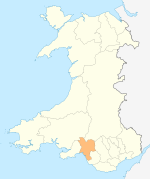Groes, Port Talbot
Groes was a village south of Port Talbot in the county of Glamorgan, Wales. It was demolished in 1976 to make way for Junction 39 of the new M4 motorway.[1][2]
The village was built in the 1830s, designed by the architect Edward Haycock.[1] It included the octagonal Beulah Calvinistic Methodist Chapel (built in 1838) and later a school (built in 1860);[2] the school was paid for by Christopher Rice Mansel Talbot, then owner of Margam Castle.[3]
Despite Port Talbot Council's deputy engineer proposing an alternative route for the M4 motorway, in 1974 it was confirmed the village would be destroyed.[1] The village's 21 families were rehoused and the houses and school were demolished in 1976.[2] A new school had been built in nearby Margam in 1973, while the Beulah Chapel was dismantled and rebuilt in the nearby Tollgate Park.[2]
References[edit]
- ^ a b c "Invisible Scars" (blog). Port Talbot Historical Society. 4 September 2013. Retrieved 5 December 2017.
- ^ a b c d Geraint Thomas (3 December 2017). "The 'Cotswolds-like' Welsh village reduced to rubble to make way for the M4". Wales Online. Retrieved 5 December 2017.
- ^ "Topping out ceremony marks key milestone in the construction of Ysgol Cwm Brombil". Neath Port Talbot County Borough Council. 13 February 2018. Retrieved 9 May 2018.
51°34′07″N 3°44′47″W / 51.5686°N 3.7463°W

